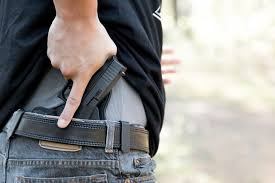While my friends in the gun-control community continue to go ga-ga over something as silly and unimportant as plastic guns, a decision just came down from the 9th Circuit Federal Court which could have a much greater impact on the whole issue of gun violence and how America will and will not regulate guns. I am referring to an appeal brought before the Court by a resident of Hawaii, George Young, who was denied an application both to openly a gun as well as to carry the same gun concealed.
Basically, what the Court said in a 2 – 1 opinion, was that the State of Hawaii couldn’t have it both ways. Either they had to let Young carry a weapon outside the home openly, or they had to let him carry his weapon concealed. But to deny him any ability to leave his home armed was to deny his 2nd-Amendment ‘rights.’ The Court found that Hawaii’s statute denying carrying of weapons except in cases of engaging in ‘protection of life and property’ was too vague and could not sustained under current 2nd-Amendment interpretations, up to and including the Heller decision rendered in 2008.
In fact, Scalia’s 2008 Heller opinion specifically avoided the issue of carrying a gun outside the home, because the D.C. law which Heller appealed only dealt with whether or not a resident of the District could keep a loaded, self-defense gun in the home. The relevant section in the 2nd Amendment is the phrase, ‘keep and bear arms,’ with decisions since 2008 coming down on both sides of this issue when deciding whether ‘keep’ and ‘bear’ refer to only inside the home or outside the home as well.
If you go back and read Scalia’s Heller opinion, what I find interesting is that virtually the entire 20,000-word text is devoted to historical and legal discussions about the words ‘keep’ and ‘bear.’ On the other hand, the word ‘arms’ is given very short shrift, Scalia dispensing with it altogether by noting that modern military weapons, like an M-16 rifle, could lie outside of 2nd-Amendment protection because such a gun isn’t commonly found in the home (page 54 et. seq.) In other words, for purposes of defining the types of weapons which fall under 2nd-Amendment ‘rights,’ Scalia is basically saying that a gun used by the military may, in fact, be what he calls a ‘dangerous and unusual’ weapon, which should not be owned by civilians at all.
If my friends in the gun-control community decide to appeal the 9th Circuit’s ruling, which I’m sure they will, and/or if the issue of 2nd Amendment protection for carrying a gun outside the home finally arrives at the doorstep of the Supreme Court, perhaps some consideration might be given to looking at the whole issue not from the point of view of prohibiting or regulating the behavior of people who own guns, but rather, in terms o the lethality of the guns themselves.
Because it just so happens that if we define a gun not in terms of whether it can be found in a gun-owner’s home, but rather in terms of whether the gun was designed for military use and is used by the military today, then all of a sudden, the whole question of what constitutes a gun whose existence in civilian hands is covered by the 2nd Amendment begins to change.
The fact is that the most popular handgun in America – Glock – was designed specifically as an army gun and is carried by troops in the field, including U.S. troops, all over the globe. Ditto the guns manufactured by Sig, whose M17 model just became the official sidearm of the Regular Army of the USA. Ditto the Beretta M9, the list goes on and on.
The reason that other advanced countries don’t suffer our level of gun violence is because they recognize that arms designed for the military are too lethal to be in civilian hands. How come this issue never seems to be arise when my friends in the gun-control community decry the violence caused by guns?


 If this bill is enacted into law, each state would be required to honor a concealed carry permit issued by another state, even if the permit holder’s state of residence has much lower standards or no permit requirement at all for those carrying concealed weapons. This would be a dangerous law, as it would allow people to seamlessly carry guns across state lines, regardless of the vetting and training required by the state issuing the permit.
If this bill is enacted into law, each state would be required to honor a concealed carry permit issued by another state, even if the permit holder’s state of residence has much lower standards or no permit requirement at all for those carrying concealed weapons. This would be a dangerous law, as it would allow people to seamlessly carry guns across state lines, regardless of the vetting and training required by the state issuing the permit.